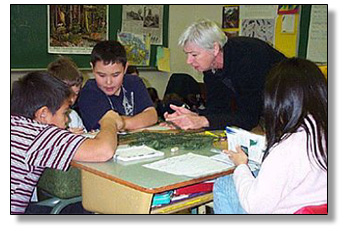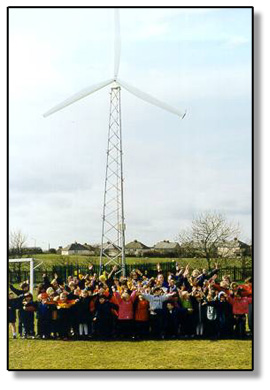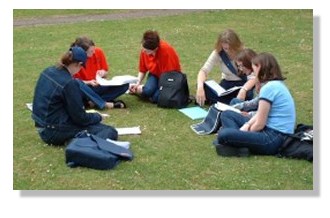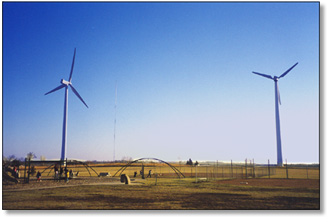Seventeen towns were chosen for their potential wind resource and contacted to judge their interest in pursuing a project. Schools were contacted first by letter, followed by individual meetings when interest was expressed. Staff members from the Laboratory are helping these communities evaluate their situation, analyze costs and benefits and assist in determining whether wind power makes sense for each district. Each town’s specific situation is evaluated: available sites, transmission capabilities and accessibility and the demand and tariff structures for each service area. Computer-based spreadsheets are used to conduct initial economic and financial analyses.
The Laboratory’s staff members are exploring the sale of green tags as the main revenue stream to pay off a turbine. If green tags are the revenue source, as opposed to grants and loans, these projects can be replicated on a wide scale.
Updates on the Wind for Schools pilot program can be found on the Wind Powering America Web site. That initial thought, together with a little reading and a lot of work, led to the 250-kilowatt turbine that now turns in the wind near the district’s elementary school. A partnership with the Iowa Department of Natural Resources and a grant from the U.S. Department of Energy helped make the project possible. The turbine provides all of the elementary school’s energy, and with the $20,000-$25,000 annual savings on utility bills, the district paid for the turbine in a little more than five years. According to Tirevold, the school has netted $140,000 from the turbine to date, and that money goes directly into district coffers.
The original turbine was such a success that the district pursued a second, larger turbine. The new 750-kilowatt turbine produces six times as much electricity as the first machine and is connected to the utility grid.
“The 250-kilowatt turbine takes care of the elementary school,” Tirevold said. “The 750-kilowatt turbine takes care of the high school, middle school, administrative buildings and then some.”
The local utility pays Spirit Lake for the unused energy, and the money that would have paid the utility for electricity pays off the loan. Tirevold calculates that the 750-kilowatt turbine will pay for itself by 2007, just six years after it became operational.
“After that, Spirit Lake will have $140,000 a year — on top of the money saved from the smaller turbine — to spend on education,” he said.

Children's wind art Speaking of education, the wind turbine has contributed more than savings for the district. It has provided a functioning “laboratory” that students can use to learn about physics, electricity, math, society and even creative writing. The school uses lesson plans to help connect the turbine turning in the wind outside to the learning taking place inside the classroom. For example, the lesson “How Wind Is Changed into Light” helps fourth-graders learn about different forms of energy and how the wind’s energy can be converted into electric energy that powers equipment and lighting in the classroom.
Several other Iowa schools also own wind turbines. The Forest City Community School has a 600-kilowatt turbine financed through a combination of a loan from the Iowa Energy Center’s Alternative Energy Revolving Loan Program and a low-interest loan from a local bank.
“When we got started, no grant monies were available for a wind project. We understood we’d have to finance it, so we spent seven or eight months looking at the figures,” says Superintendent Dwight Pierson. “We really felt it could pay for itself and become an asset for the district. At the time, we had one of the only turbines around that was totally financed, all through conventional loans.”
The school received a Federal Renewable Energy Production Incentive of 1.5 cents per kilowatthour. Including the incentive, the turbine has generated $284,000 (more than 4.7 million kilowatthours) worth of electricity between January 1999, when it became operational, and February 2004.
“Installing the turbine was a bold decision for our board to make,” Pierson says, “but its decision was made on good input, and the cost investment penciled out.”

Opportunities to study wind power In Forest City’s case, the idea to install a wind turbine came from a student, not an adult. Paul Smith, a student in Ron Kvale’s physics class, became interested in wind energy. Smith measured the school’s wind resource and found that the school’s land might be a viable site for a turbine. Smith and Kvale took their findings to the school board, the board was intrigued, and the project took flight. An energy audit helped reduce the school’s energy use so that less of the valuable electricity produced by the wind turbine would be wasted.
Pierson speaks of the Forest City turbine with pride. “This has been a win-win for our community, a real asset,” he said. “And we actually underestimated how much of an asset it would be.”
Iowa schools aren’t the only ones that save money, reduce emissions and provide students with a real-life opportunity to see wind energy in action. People in Massachusetts, Minnesota, Pennsylvania, Vermont, Illinois, Colorado and Michigan have worked to pair wind turbines with schools in their states. Additional projects can be found on Native American and state trust lands. And each of these projects has a different story behind how the community launched
 the idea and which financial paths it took to make school wind production a reality.
the idea and which financial paths it took to make school wind production a reality.In Colorado, the town of Wray is about to become the first district in the state to make a school wind project a reality. The Wray RD-2 district plans to install a 1.5-1.7 megawatt turbine on a hill south of the city by March of 2005.
Agriculture education teacher Jay Clapper is waiting for a grant, but he’s confident that it will come through. The district hopes to have the turbine erected in Spring 2005.
The turbine will be tied to the municipality’s utility grid, and the school will sell the electricity generated to the city. The turbine will provide approximately one-fourth of the city’s power. Plus, the district will market the project’s “green tags,” which represent the electricity’s environmental or “green” attributes. Green tags can be sold to a third-party buyer who then sells the tags, mostly to urban customers who are willing to pay more for clean energy. Selling the project’s green tags will help the school tap into a growing national market that will generate additional revenue for the project.Between the value of the electricity and the green tags, the Wray district expects to gross about $300,000 per year. This money will help the district enormously.
“Our district went through tremendous budget cuts — nearly one-fifth of our budget — and student enrollment was going down,” Clapper said. “I had always talked about wind and renewable energy in my classes. I said that we should have a wind turbine up on that bluff to offset our costs!” And now, after two and a half years of effort, the district’s hard work is about to pay off. Clapper’s advice: “Don’t quit! It can be a long road, but you can get there.”

Students discuss wind power Clapper’s encouragement is echoed by many school wind project advocates. Besides a willingness to stay the course, those with experience say that successful projects benefit from creative thinking. People involved in school wind projects tend to find unique solutions for their individual school’s situation. For small communities, creative thinking can bring wind projects to life.
Successful school districts seek state and federal incentives, as well as utility support. In the case of the Forest City turbine, Pierson says that a lot depended on having a good contract with the local utility.
“Our contract is very simple: we trade electricity,” he said. “They buy any electricity we don’t use, and we buy any extra electricity the turbine doesn’t provide. They are 100 percent behind us, and that has made all the difference.”
But perhaps the most important thing that school wind projects have in common is saving districts money — money that can be returned to the schools to help bolster revenue and enrich student education. When asked what he would say to someone from a district that is interested in installing a wind project, Tirevold paused and said, “What? You mean you don’t have one yet?”
For more information use the following links: Spirit Lake School District
Forest City School District
Wray School District RD-2
American Wind Energy Association
National Renewable Energy Laboratory’s Wind Powering America program
Wind Energy Resource Atlas
This article was prepared with information provided by the U.S. Department of Energy's Wind Powering America Program. For more information, please visit www.windpoweringamerica.gov Disclaimer Energy Office Home Privacy Policy/Accessibility
